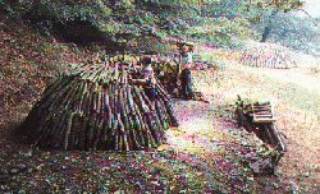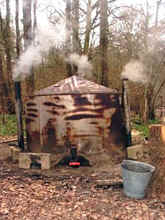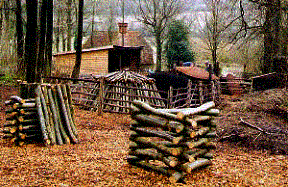|
In the 1830's, a blast furnace for the manufacturing of pig iron was put into operation, in the Van Deusenville section of Great Barrington. While the furnace would have required a relatively small crew to operate it, many more workers would have been needed as tree cutters, charcoal burners (colliers), ore diggers and limestone miners.
Charcoal was used as fuel because it is pure carbon and burns cleanly, producing intense heat. In order to produce charcoal, the charcoal burner would level a circular area, about thirty feet in diameter. Four-foot lengths of small wood would be stacked around a central flue to form a dome-shaped mound. This was then covered with turf and soil to exclude air. The stack was lit and burned for several days with a restricted air supply, turning the wood to charcoal.
By the late 19th Century, when George Petitjean entered the field, the mound had probably been replaced by a steel kiln as pictured below.
The charcoal burner's life was
somewhat itinerant, because he had to follow in the footsteps of the wood cutters,
as they found trees to cut down. The
charcoal hearths needed constant attention, so the charcoal burners and
their families often lived out in the woods in temporary shelters.
Charcoal Hut
The map below indicates the movement of the George Petitjean family, over the course of the years 1859, to at least 1876. By 1880, the family had moved to Waterbury, CT, and George had become a laborer at the West Brass Company.
|



